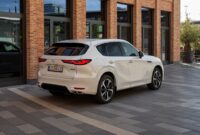We love the philosophy of solar carswhich are recharged parked in the sun. But is this the future of the electric car?
The idea that your electric car can be recharged while parked in the sun is, to say the least, suggestive. That it gains autonomy, that you can travel more kilometers, without having to connect it to a charging point. Free kilometers. Less dependence on a charging point and a private garage in which to have a wall charger.
They are all advantages. That is why we like the idea of the solar car so much, of electric cars that take advantage of the extension of their bodywork to have solar panels. that allow, little by little, to recharge the battery, when our car is parked in the sun, but also on the move.
Now, are we facing a utopia, even a hoax? Is it a real solution for the future?
In the coming years there will be a flood of electric cars equipped with solar panels, are they the future of the electric car?
Advantages and disadvantages of solar energy in an electric car
Beyond how interesting it may be for us to recharge an electric car, without further ado, using free and virtually unlimited energy such as solar energy, we must highlight the first advantages it presents, and the disadvantages, to use solar energy in your recharge:
- The biggest advantage of a solar electric car is to take advantage of the fact that most of the time it will remain parked. If it remains parked in the sun, it will take advantage of that time to recharge its batteries.
- The biggest drawback of a solar electric car It is the limited area available to maximize the area occupied by the solar panels that will recharge your batteries.
On the other hand, solar recharging is totally dependent on weather conditions, the solar recharging time is limited and also depends on the hours of greatest solar irradiation and, on the other hand, and unlike the systems used in solar power plants, neither our car, nor its solar panels, will be able to automatically orient themselves to maximize performance.
This means that, even with solar panels with the latest technology and great efficiency, which will not be the case in a car, the charging power under normal conditions will always be, or in most cases, very low. below the power installed in the solar panels that cover the body. Hence, it is reasonable for us to ask ourselves if it would not be better, and a more optimal, efficient and economical solution, to buy any of the electric cars available in the market and opt for self-consumption solutions at home.
An electric car could spend most of its life parked in the sun, and make the most of solar energy, but the area available on its body to install solar panels is very limited and insufficient to offer a high solar charging capacity.
How much autonomy can a solar car recharge?
In recent months, it has become known different electric vehicles that have solar panels and, therefore, have the ability to recharge their batteries while they remain parked, or moving, in the sunsome of which will be available on the market in 2023.
The creators of these electric vehicles usually provide us, in some cases, the power of the solar panels, the autonomy recharged in time in ideal conditions, or even estimates of autonomy recharged in time under less optimistic conditions, trying to find an estimate of actual performance.
Aptera’s futuristic solar car
These days, Aptera has revealed more details of a no less ambitious electric and solar car, with a futuristic and capricious design, with three wheels, and a front axle separated from the body that gives it that airship look. Aptera promises that with the most favorable solar panel configuration (on the front hood, on the rear overhang, on the rear window, on the dash and on the roof), which means paying an extra $900, it has a power installed in 700W solar panels and capacity to recharge up to 64 additional kilometers of autonomy per day.
Aptera’s solar car gains up to 64 kilometers of “free” autonomy per day
Lightyear’s solar car
With a huge body – the Lightyear 0 is almost as long as a Mercedes S-Class – its creators have managed to install 5 square meters of solar panels. Estimating a consumption of 10.5 kWh/100 kilometers, the Lightyear 0 promises a range recharge of up to 70 kilometers per day in ideal conditions. In any event, they also acknowledge that in less favorable conditions, the daily autonomy recharge with solar energy would be reduced to about 32 kilometers.
Lightyear’s solar car promises between 32 and 70 kilometers of autonomy per day recharging in the sun
The Squad Solar Light Quadricycle
Of all the electric and solar vehicles that we have seen these days, the Squad Solar City Car is the most urban, a light quadricycle approved under the L6 classification, limited to 45 km/h and weighing less than 350 kilograms. Its solar panels allow to recover up to 20 kilometers of autonomy per day, in ideal conditions.
The Squad quad gets 20 kilometers of range per day parked in the sun
The XBUS electric and solar campervan
One of the most capricious and suggestive proposals is that of XBUS, which proposes a kind of light quadricycle of the modular van type, which will include a camper-type configuration. The figures provided by its creators are, without a doubt, the most surprising, so much so that they have been too beautiful to be true. Still, its creators promise that will recharge up to 200 kilometers of autonomy per day with solar energyin ideal conditions, and in its configuration of modules that includes more solar panels, which has an installed power of 800W.
The XBUS solar camper promises to recover up to 200 kilometers of autonomy per day
The most familiar solar car Sono Sion
Sono Motors has also revealed more details of its proposal for a solar electric car, in a minivan format, a family and spacious proposal, which will start at 25,126 euros. Sono Motors has covered a good part of the Sion’s body, including the side panels, with solar panels and promises an autonomy recharge of up to 35 kilometers a day in ideal conditionsnoting that in more realistic conditions it would be reduced to about 16 kilometers.
Sono’s is undoubtedly one of the most interesting projects. For proposing a solar car that would be at prices very similar to those of some electric cars that do not exceed €30,000.
The Sono Sion project makes very realistic forecasts, promising between 16 and 35 kilometers per day recovered
More solar and renewable energy, fewer solar cars
In any case, and given the limitations and, why not say it, the cost involved in installing solar panels in an electric car, the future we should be heading towards does not involve more solar cars, but rather to promote the generation of renewable energies and the charging infrastructure:
- the future is more installed power from renewableswhich allows the energy with which we recharge our electric cars to come from sources that do not emit COtwo to generate energy, and provide it at a reasonable price.
- the future is a wide charging networkwhich facilitates the recharging of electric vehicles on trips with direct current and high power connections, but also in the city, thinking above all of those who have difficulties having a wall charger in a private garage.
- the future is also have charging stations that integrate generation solutions that, even having a larger area than a car to incorporate photovoltaic panels, it would hardly be enough for self-generation and offer high load power, but they would contribute to having more sustainable energy.
- The future also involves a much more recommendable option than buying a solar car, but only viable for a very specific type of home, that of self-consumption. Install solar panels at hometo partially or totally supply electrical energy to our home, and also take advantage of it to recharge our electric car.







